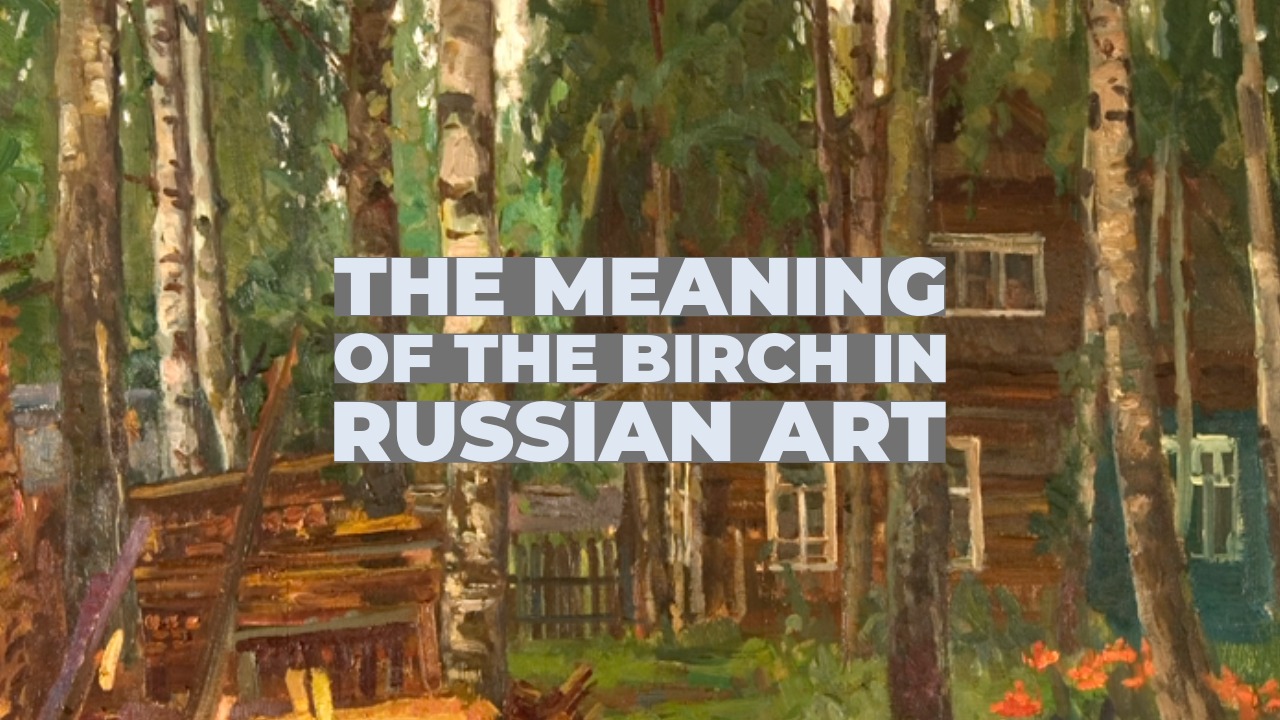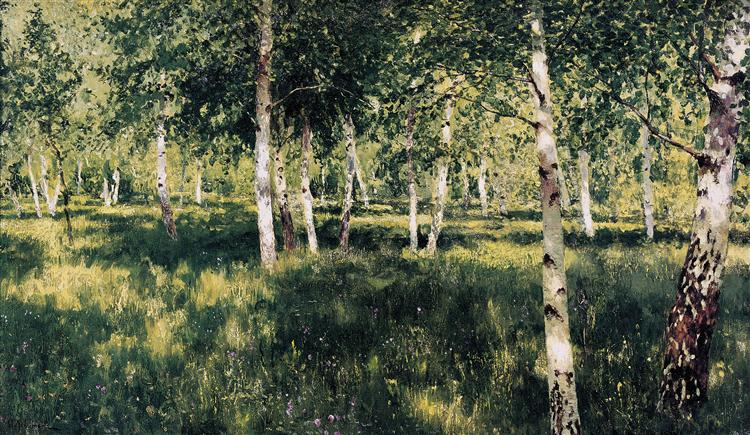The Birch Tree in Russian Art

The birch tree holds a special place in the Russian imagination. More than just a common feature of the landscape, it became a powerful symbol in art, representing the very soul of the nation. For realist painters of the 19th and 20th centuries, the birch was a versatile tool used to explore themes of national identity, spirituality, and the profound, often complicated, Russian connection to nature.
Key Takeaways
- A Unique National Symbol: The birch tree serves as a quintessential symbol of Russia in art, a role unparalleled by any single natural element in Western European painting. It acts as a visual shorthand for the motherland.
- Spirituality in Nature: Influenced by Romanticism, Russian artists saw nature as a direct link to the divine. Landscape painting became a spiritual act, with the natural world seen as a vessel for God.
- Emotional Complexity: Artists like Isaac Levitan used the birch grove to express a dualism of intense joy and underlying anxiety, often trapping the viewer within dense foliage to create a sense of claustrophobia.
- A Lasting Tradition: The realist tradition of landscape painting continued through institutions like the Surikov Art Institute, with masters like Nikita Fedosov advancing the craft through unique and painstaking techniques in the 20th century.
The Birch Tree as a Symbol of Russia
In Russian landscape painting, the birch tree is the ultimate artistic symbol of the nation. Art historians consider it the single element that best expresses Russia's identity. In fact, some scholars have called the birch a synecdoche for Russian landscape—where a single part (the tree) represents the entire whole (the Russian motherland). This central status given to one type of tree is exceptional in art history. You would not find an entire genre dedicated to an "Oak Grove" by Monet or other French Impressionists, nor would you see this focus among major British or German artists.
The birch tree's powerful presence in art reflects a key moment in the nation's history. The Russian artistic tradition was finding its voice in the 19th century as the country struggled with its identity. Torn between embracing Western European culture and celebrating its own unique Slavic character, artists turned to the familiar, native landscape. The humble birch became the perfect vehicle to express what was uniquely and authentically Russian.

Isaac Levitan's "Birch Grove"
Nature and the Divine Connection
The European Romantic movement had a major impact on Russian culture, bringing with it the powerful philosophical idea that "Nature is God." This concept completely changed how Russian landscape painters saw the world around them. For these artists, painting a landscape was no longer just about capturing a pretty scene; it became a spiritual practice.
Art Movements at a Glance
Romanticism: An artistic and philosophical movement that prioritized intense emotion, individualism, and the awe-inspiring power of nature. For Romantics, the natural world was a source of spiritual truth.
Realism: A movement that aimed to represent subjects truthfully, without artificiality or supernatural elements. In Russia, this often included capturing the 'emotional truth' and social realities of the landscape and its people.
Early realist painters like Ivan Kramskoy found that creating landscape art aligned perfectly with their deep Christian spirituality. They saw the natural world as a conduit, or a channel, between humanity and the Divine. Later, for painters like Mikhail Abakumov, this idea evolved into a complete communion. He viewed nature in a much more direct and factual way—as the literal vessel of the Divine. His paintings were sacred epistles through which he communicated the beauty of God’s forests, rivers, and fields.
Isaac Levitan: Master of the Moody Grove
The 19th-century master Isaac Levitan stands out as one of Russia's most important landscape artists, and he frequently used the birch grove to explore complex, and often contradictory, emotions. Levitan’s paintings of birch groves show his incredible ability to capture a mood that is both beautiful and unsettling.
On the surface, his scenes can feel intensely joyful and full of life. In a YouTube lecture, Dr. Joachim Pisarro points out in one painting where Levitan “masterfully painted sparkling details and patches of bright sunlight streaming through the leaves”, but at the same time, in other paintings “fills these same settings with a deep sense of anxiety or even claustrophobia”. He often achieved this by composing his groves “without a horizon line, effectively trapping the viewer within the lush foliage”. With no clear path or exit, you are left feeling disoriented. This ambiguous mood may have been a reflection of the artist's own life, as Levitan struggled with severe depression and even attempted suicide.
How to 'Read' a Russian Landscape Painting
- What time of day is it? Look for the soft light of dawn, dusk, or an overcast day, a favorite of artists like Fedosov for its subtle mood.
- Is there a clear path or horizon? A lack of a horizon can create a feeling of being trapped or enclosed, a technique mastered by Levitan to evoke anxiety.
- What is the overall mood? Is the scene joyful, sad, peaceful, or something in between? Russian artists used nature to mirror the human soul.
- Are there any human figures? The frequent absence of people emphasizes a direct, unmediated connection between the viewer, nature, and the divine.
The Surikov Masters: A Continuing Tradition
The practice of loading the Russian landscape with deep emotional meaning did not end in the 19th century. This artistic philosophy was carried forward, particularly through the realist tradition maintained by prestigious institutions like the Surikov Art Institute in Moscow. This school became a bastion of traditional technique and emotional depth in painting, producing generations of artists dedicated to the landscape.
 "A Birch Grove" by Nikita Fedosov
"A Birch Grove" by Nikita Fedosov
One of the most revered artists from this lineage is Nikita Fedosov (1939-1992), who is considered a legend in Russian academic art circles. Fedosov was especially known for his masterful and subtle handling of light. Unlike many artists who rely on sharp contrast between light and shadow to create drama, Fedosov deliberately chose scenes with very little contrast. He preferred to paint in the challenging light of early morning, evening, or on overcast days, when values are closest together. This approach required immense technical skill and a deep understanding of color theory.
An Enduring Symbol for Today
The power of the birch tree as a symbol of the motherland has not faded with time. This deep-rooted connection continues to resonate in modern Russia. You can see its influence in contemporary Russian films and older Soviet ones that use shots of birch forests to instantly create a sense of place and nostalgia. It appears in poetry and song as a shorthand for beauty and national pride. Even in political imagery, the birch tree is sometimes used to evoke feelings of patriotism and a connection to an authentic, rural Russian identity. This lasting presence shows just how successfully 19th-century painters transformed a simple tree into an eternal emblem of the nation's soul.
We also can’t lie, that New England would have played an even more perfect setting for our gallery, since it’s more northerly climate allows for rich, sprawling birch forests. Our gallery is housed in an otherwise beautiful an idyllic setting that draws inspiration from those manorial pastures that the Realists so loved, but if only we had more birches!
Frequently Asked Questions (FAQ)
Q1: Why is the birch tree so important in Russian culture?
A1: The birch tree is seen as a symbol of spring, purity, and light. Because it is one of the first trees to grow leaves after the long, harsh Russian winter, it represents resilience and new life. It is deeply embedded in Slavic folklore, songs, and traditions, making it a natural symbol for the motherland.
Q2: Who was Isaac Levitan?
A2: Isaac Levitan (1860-1900) was a classical Russian landscape painter who advanced the genre of the "mood landscape." He was a close friend of Anton Chekhov and is celebrated for his ability to capture the subtle emotional character of Russia's natural environments.
Q3: What makes the Russian approach to landscape painting different from the French Impressionists?
A3: While the Impressionists were primarily focused on capturing the fleeting effects of light and color in a scientific way, Russian realists were more concerned with conveying the emotional and spiritual "soul" of the landscape. For them, nature was tied to national identity and divine meaning, not just visual perception.
Q4: What is the Surikov Art Institute?
A4: The V.I. Surikov Moscow State Academic Art Institute is one of Russia's most prestigious art schools. It is known for upholding the traditions of classical and realist painting, even through the Soviet era and into the present day.

